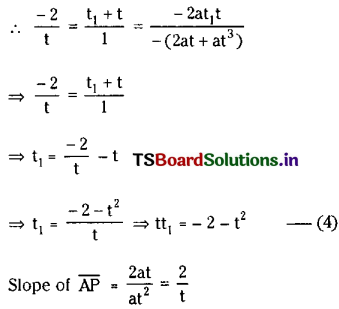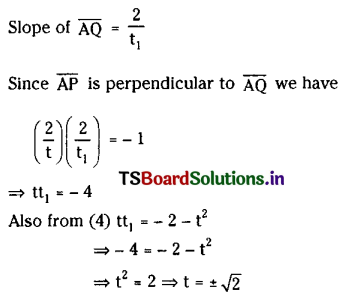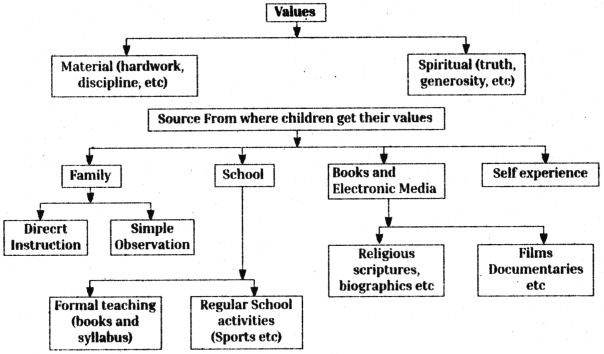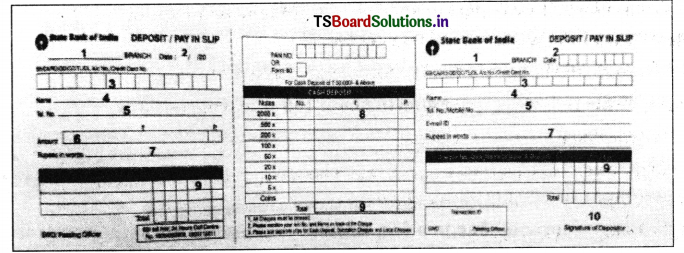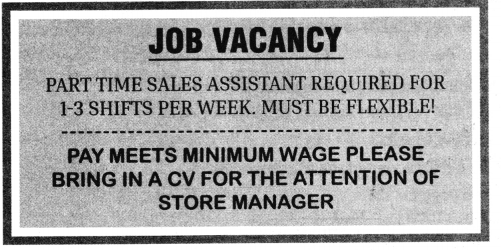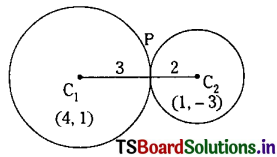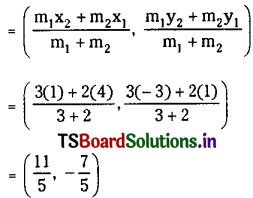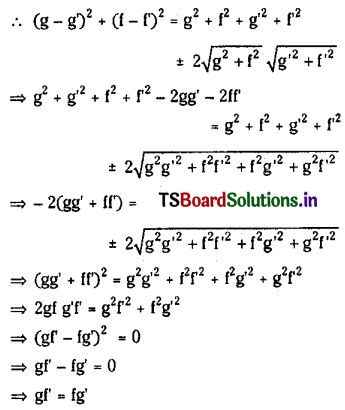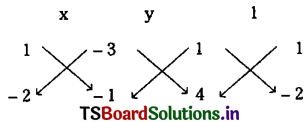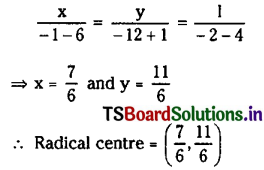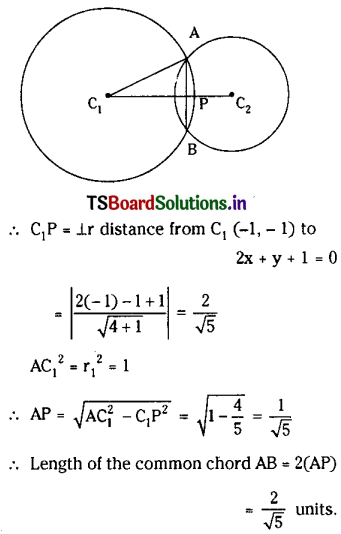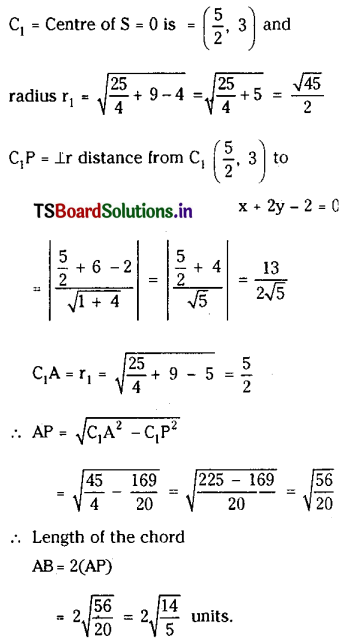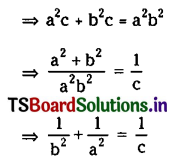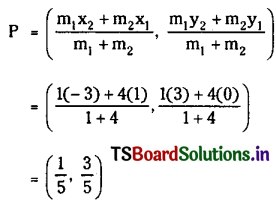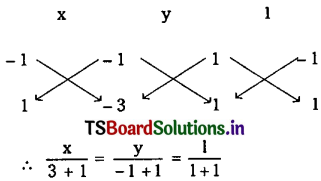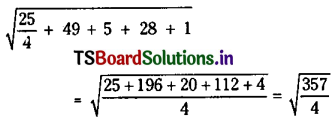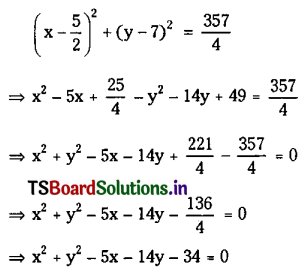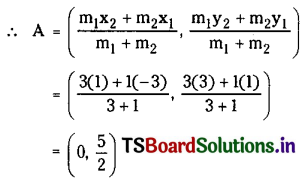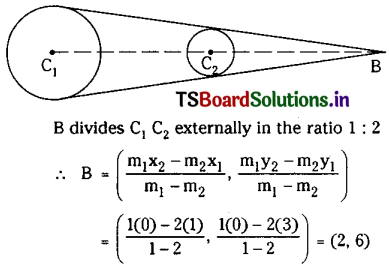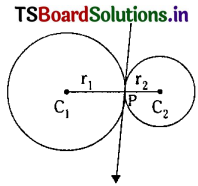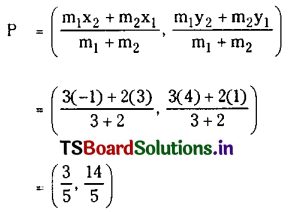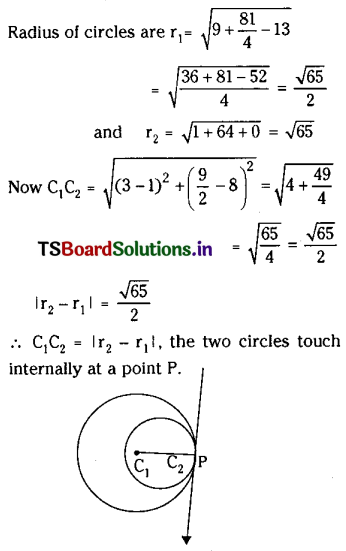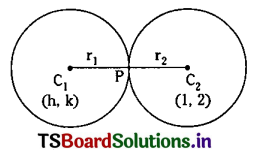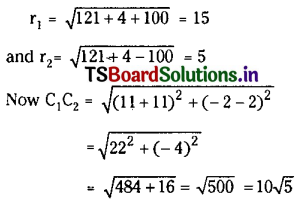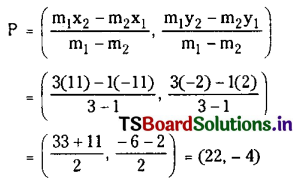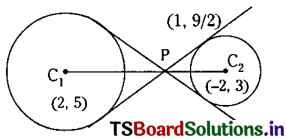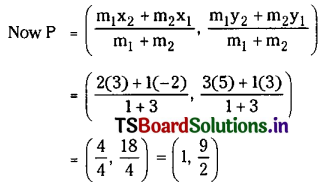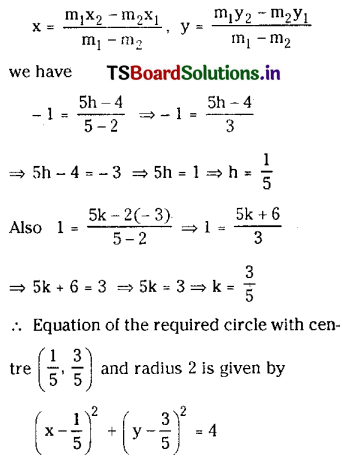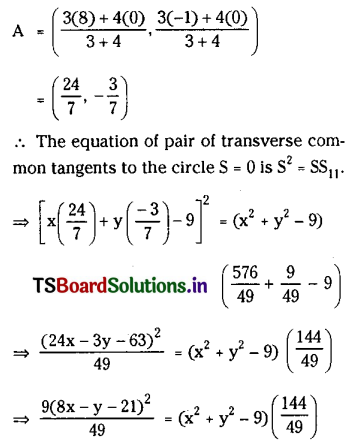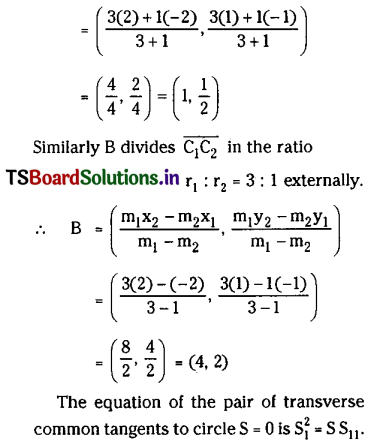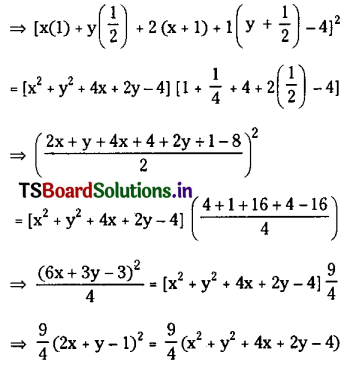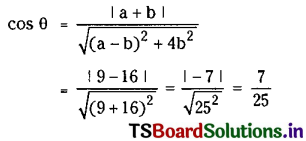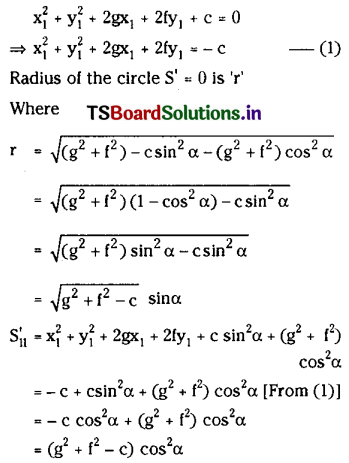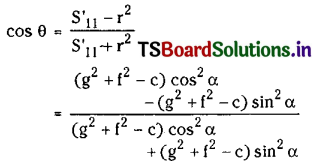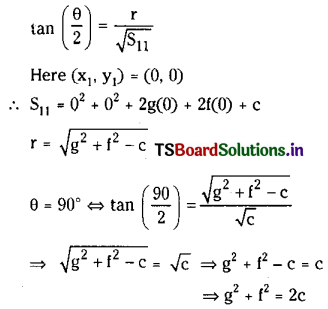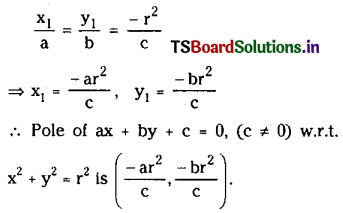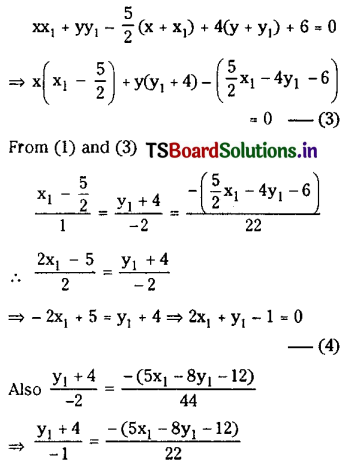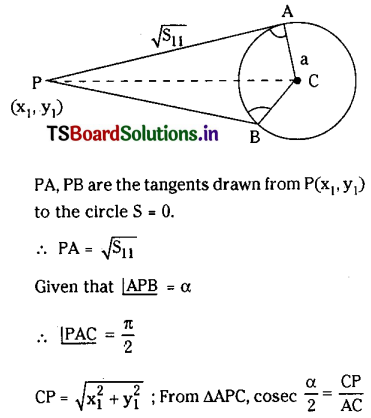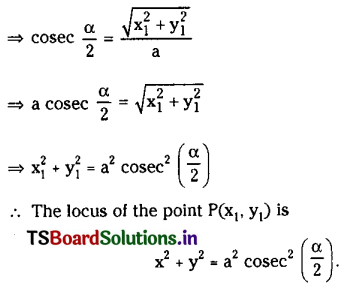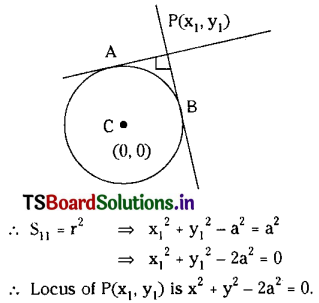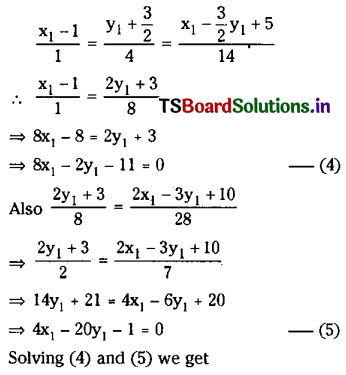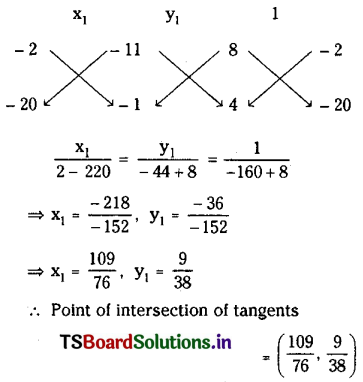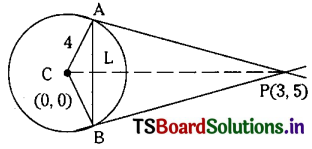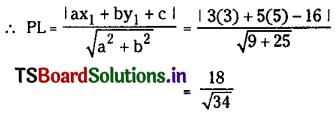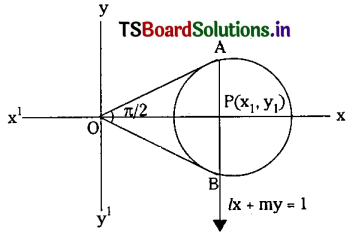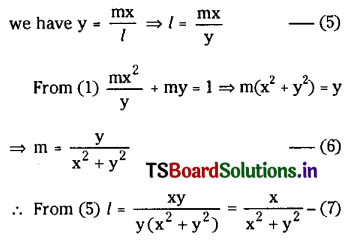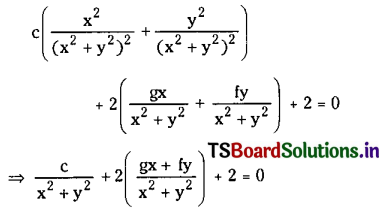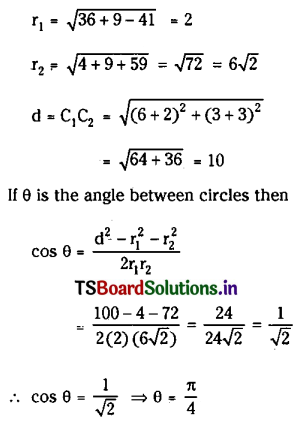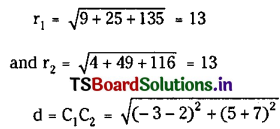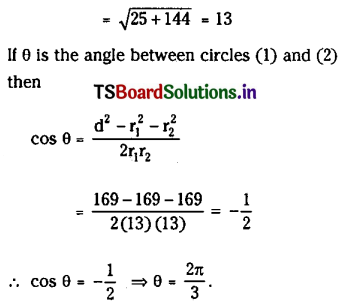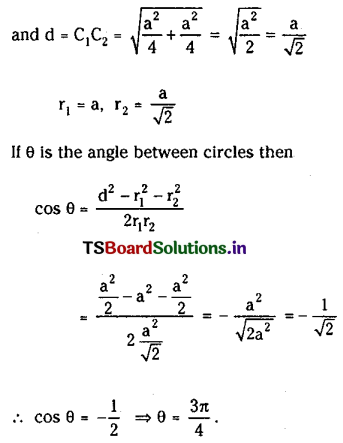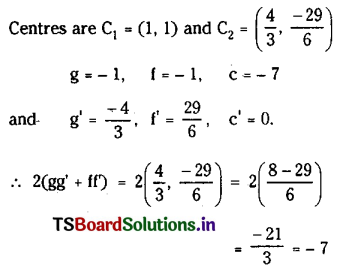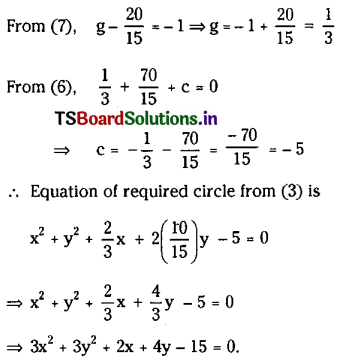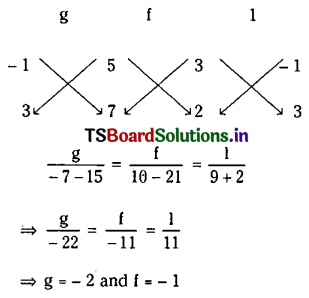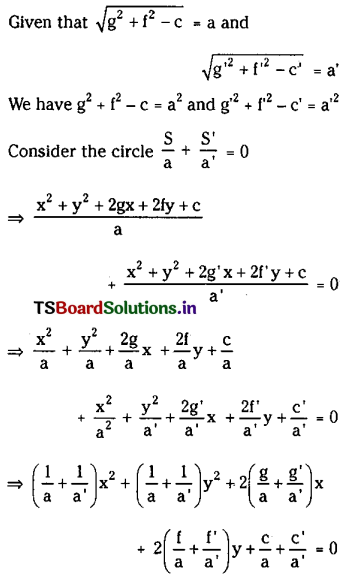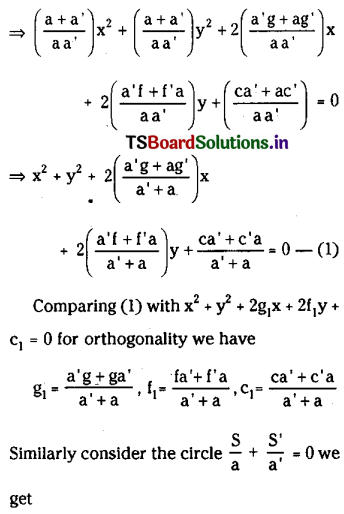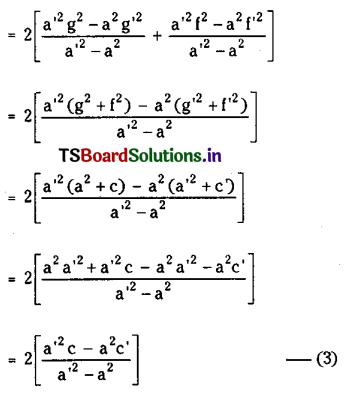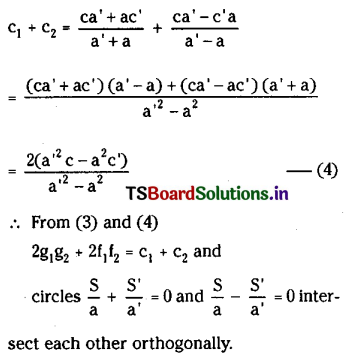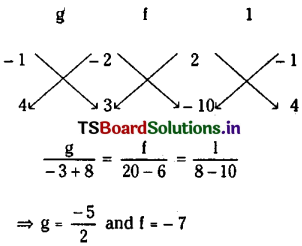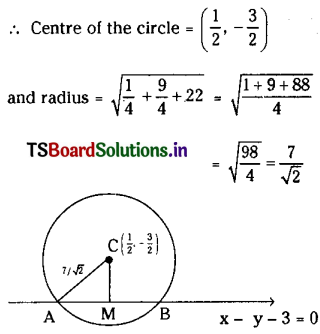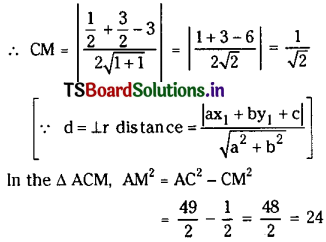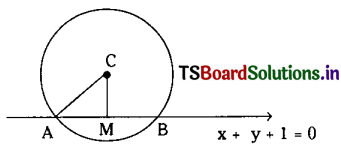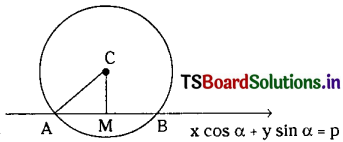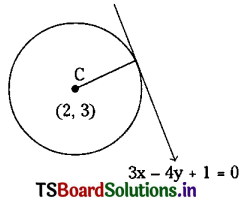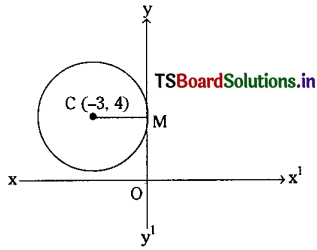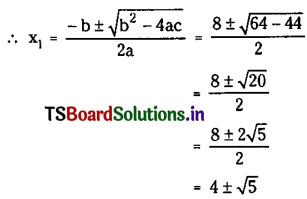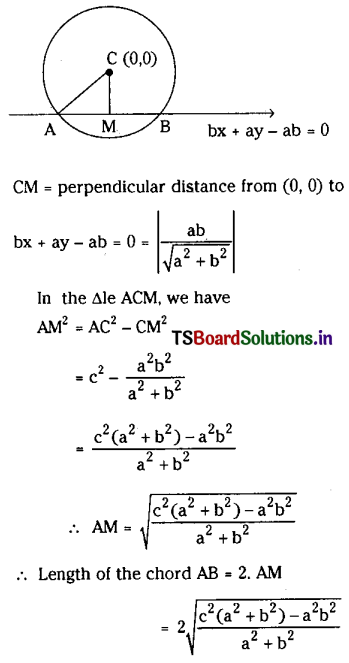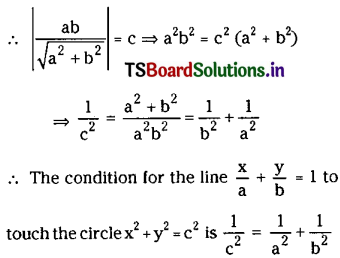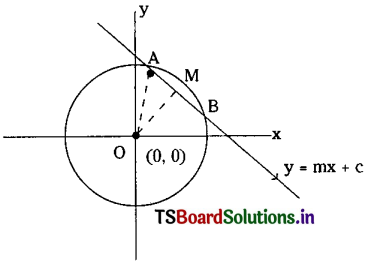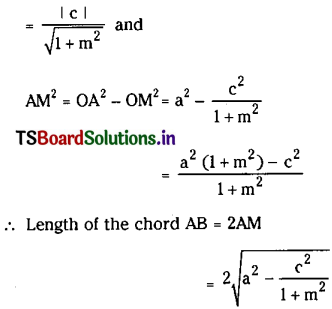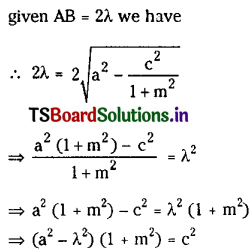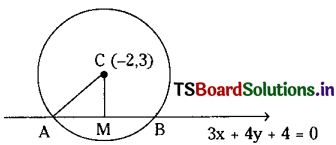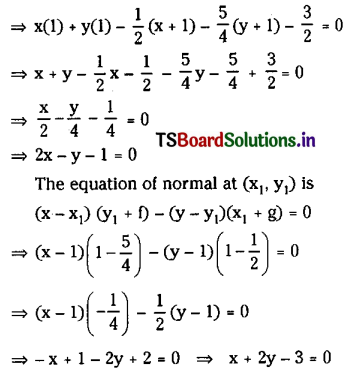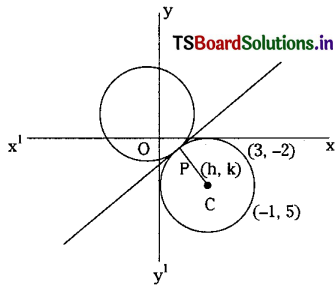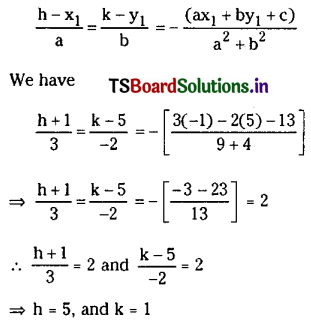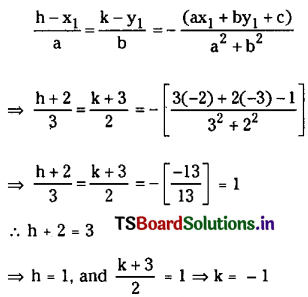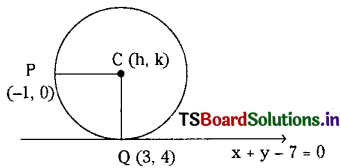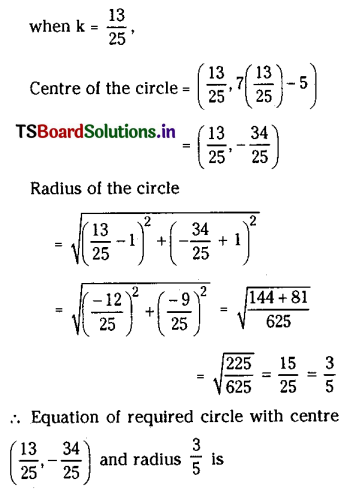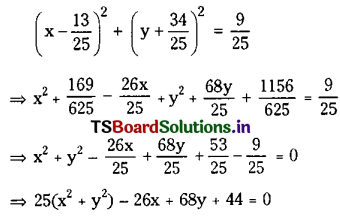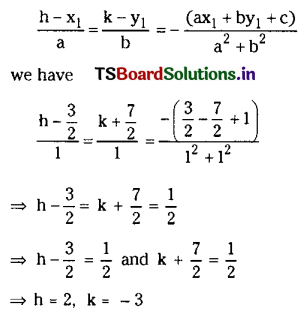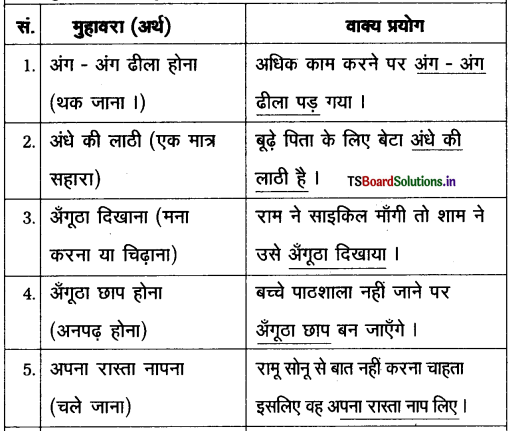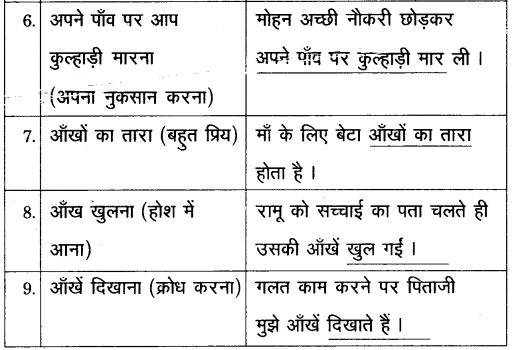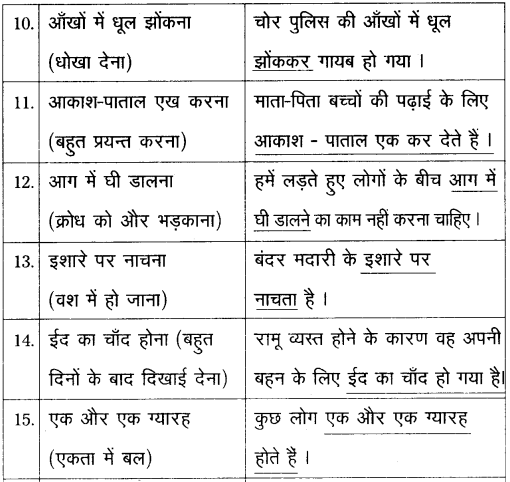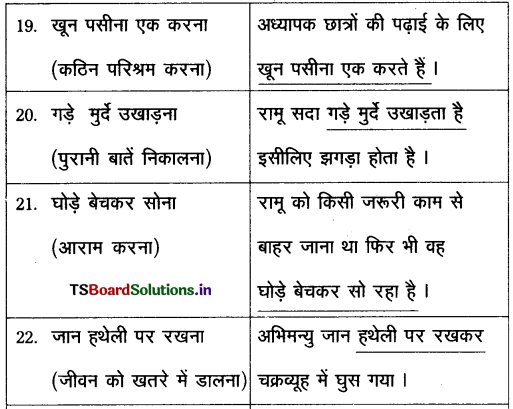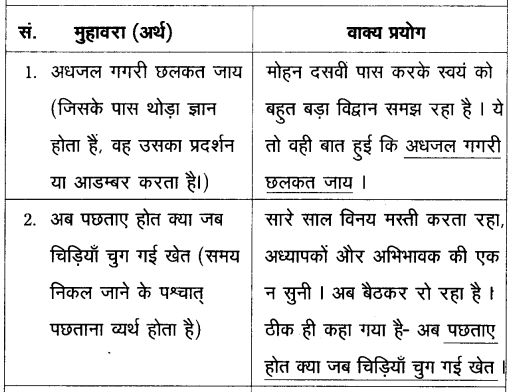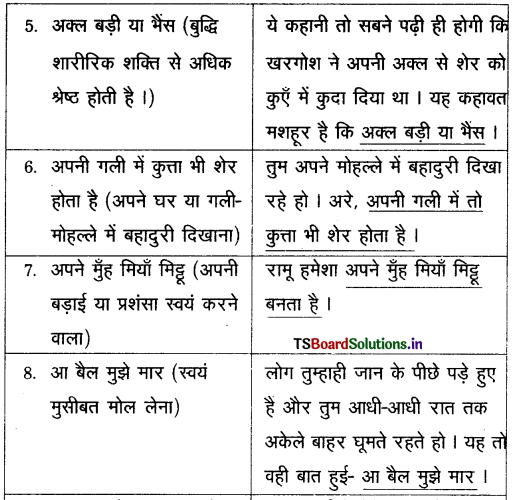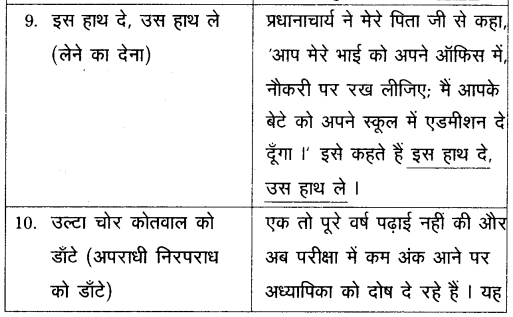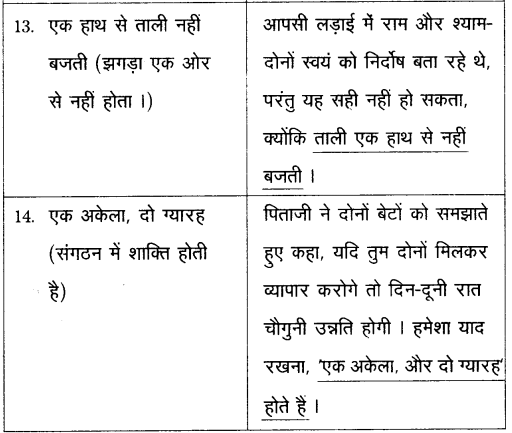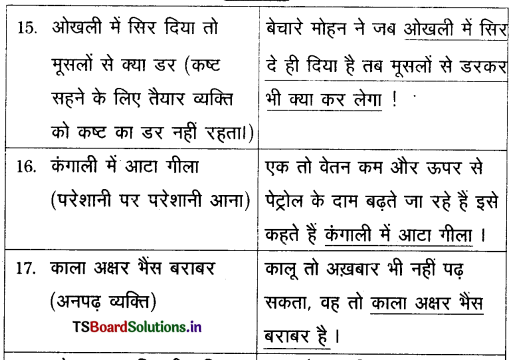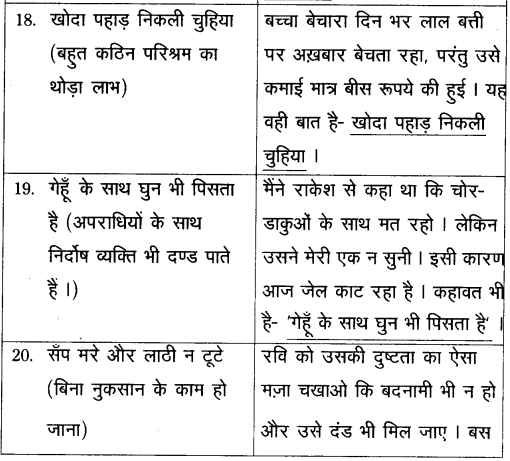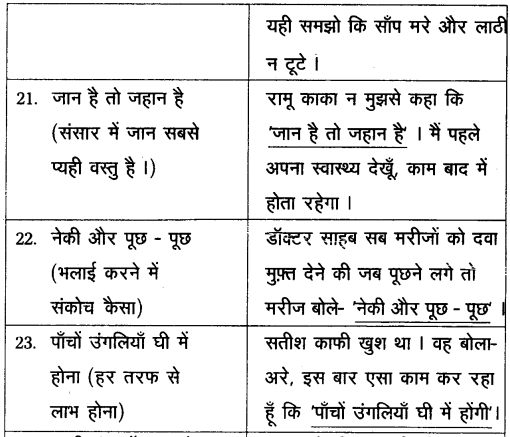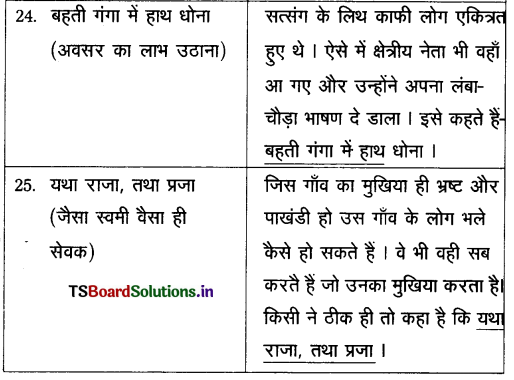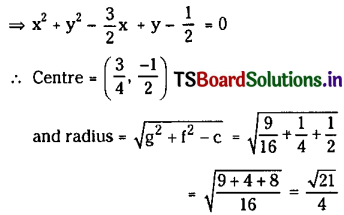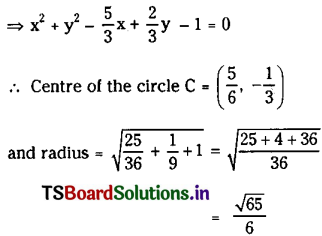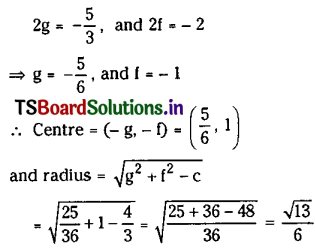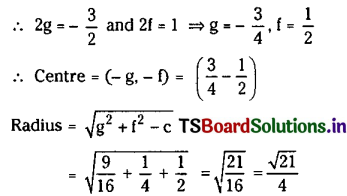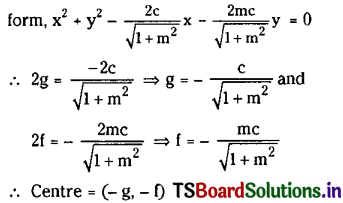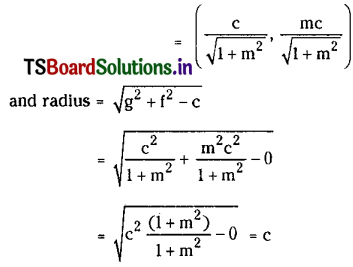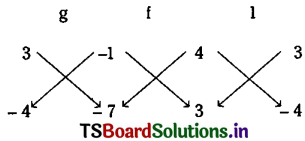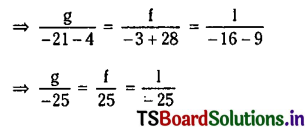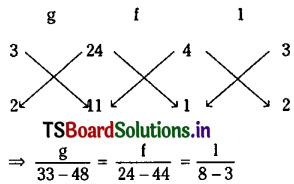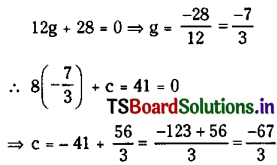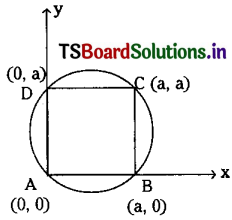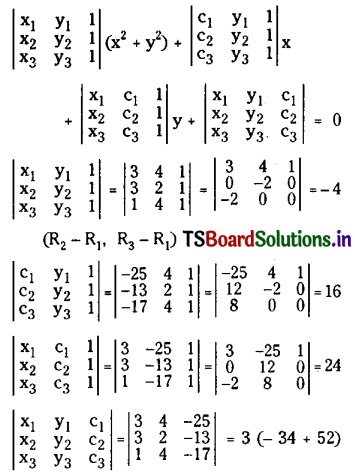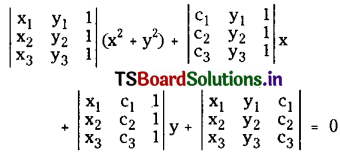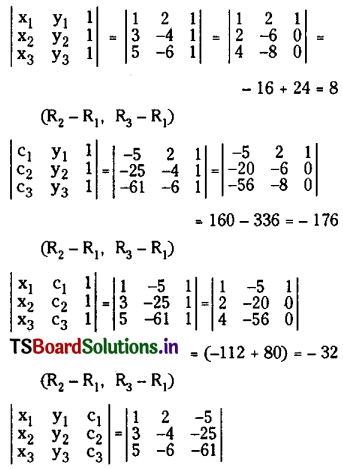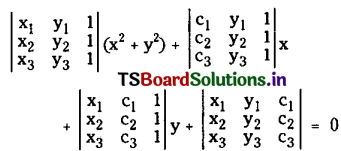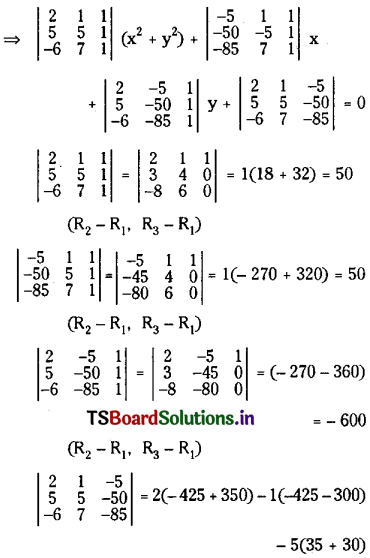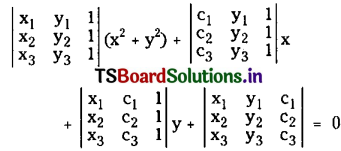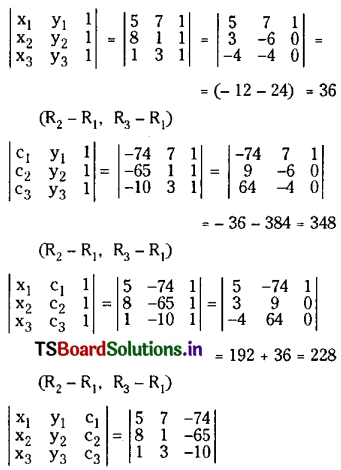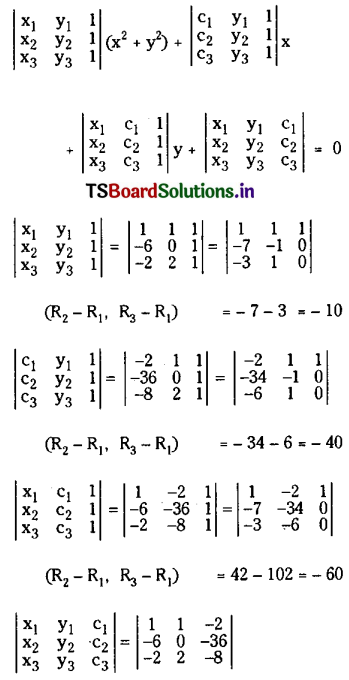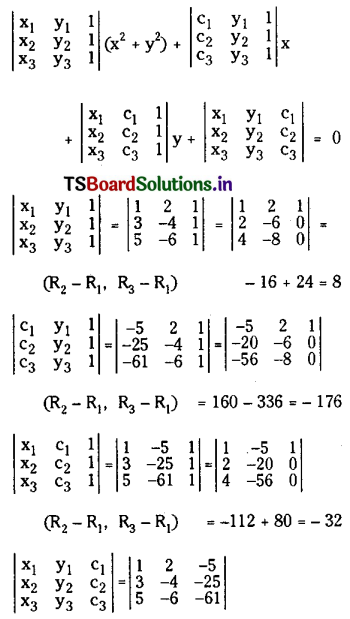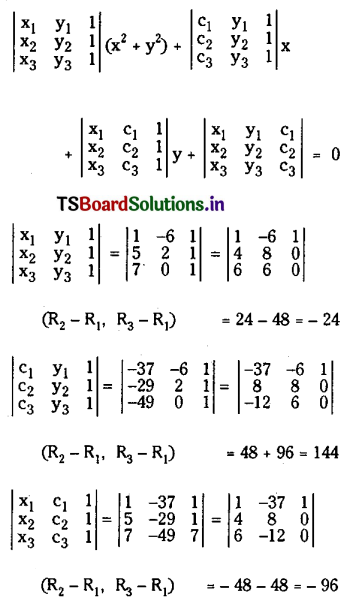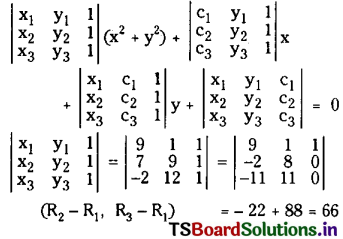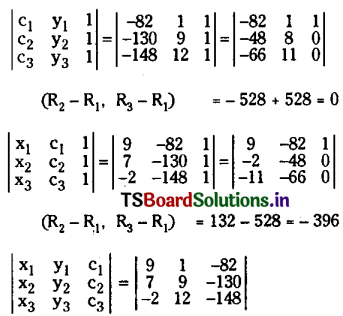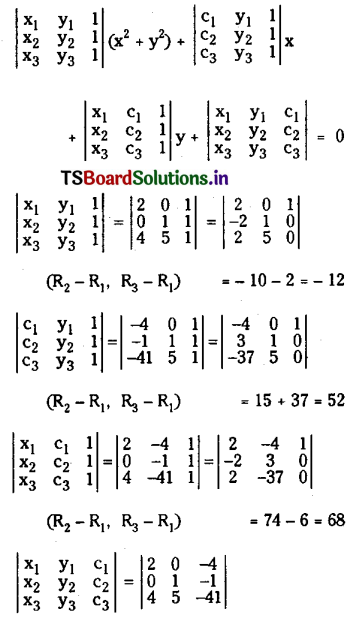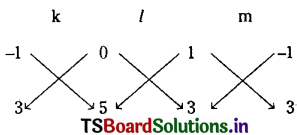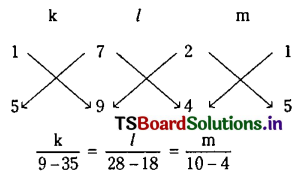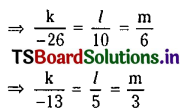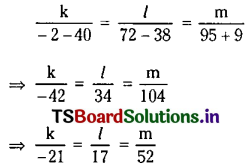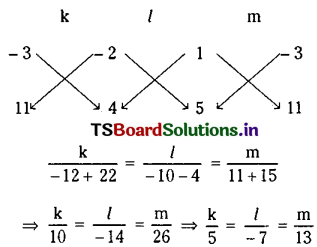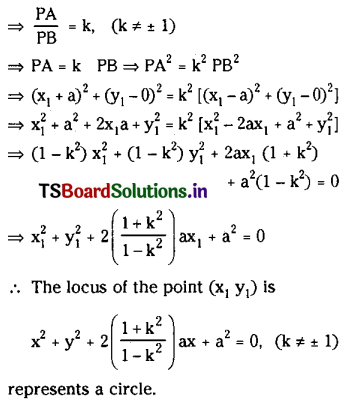Students must practice this TS Intermediate Maths 2B Solutions Chapter 3 Parabola Ex 3(b) to find a better approach to solving the problems.
TS Inter 2nd Year Maths 2B Solutions Chapter 3 Parabola Exercise 3(b)
I.
Question 1.
Find the equations of the tangent and normal to the parabola y2 = 6x at the positive end of the latus rectum.
Solution:
Given equation of parabola is y2 = 6x ……..(1)
Comparing with y2 = 4ax we get 4a = 6
⇒ a = \(\frac{3}{2}\)
Let L be the positive end of the latus rectum of the parabola y2 = 6x
∴ L = (a, 2a) = (\(\frac{3}{2}\), 3)
The equation of tangent to the parabola (1) at (\(\frac{3}{2}\), 3) is yy1 – 2a(x + x1) = 0
y(3) = 3(x + \(\frac{3}{2}\))
⇒ 3y = 3x + \(\frac{9}{2}\)
⇒ 6y = 6x + 9
⇒ 2x – 2y + 3 = 0 ……(2)
The equation of normal to the parabola (1) at (\(\frac{3}{2}\), 3) is
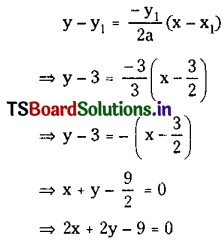
Question 2.
Find the equation of tangent and normal to the parabola x2 – 4x – 8y + 12 = 0 at (4, \(\frac{3}{2}\)).
Solution:
Given equation of parabola is x2 – 4x – 8y + 12 = 0 ……..(1)
Let P(x1, y1) = P(4, \(\frac{3}{2}\)) be the given point.
Differentiating (1) w.r.t x we get
2x – 4 – 8 \(\frac{d y}{d x}\) = 0
⇒ \(\frac{d y}{d x}=\frac{x-2}{4}\)
∴ The slope of the tangent at (4, \(\frac{3}{2}\)) is m = \(\frac{4-2}{4}=\frac{2}{4}=\frac{1}{2}\)
and slope of the normal at (4, \(\frac{3}{2}\)) is -2
The equation of a tangent to the parabola (1) at (4, \(\frac{3}{2}\)) is y – y1 = m(x – x1)
⇒ y – \(\frac{3}{2}\) = \(\frac{1}{2}\) (x – 4)
⇒ 2y – 3 = x – 4
⇒ x – 2y – 1 = 0 ………(2)
The equation of normal to the parabola (1) at (4, \(\frac{3}{2}\)) is y – y1 = \(-\frac{1}{m}\)(x – x1)
⇒ y – \(\frac{3}{2}\) = -2(x – 4)
⇒ 2y – 3 = -4(x – 4)
⇒ 4x + 2y – 19 = 0
![]()
Question 3.
Find the value of k if the line 2y = 5x + k is a tangent to the parabola y2 = 6x.
Solution:
Given the equation of the line is 2y = 5x + k.
⇒ y = \(\frac{5}{2} x+\frac{k}{2}\) which is of the form y = mx + c where m = \(\frac{5}{2}\) and c = \(\frac{k}{2}\)
Comparing y2 = 6x with y2 = 4ax we get
4a = 6 ⇒ a = \(\frac{3}{2}\)
The condition for the line y = mx + c to be a tangent to the parabola y2 = 4ax is y = mx + \(\frac{a}{m}\)
Where c = \(\frac{a}{m}\)
∴ \(\frac{k}{2}=\frac{3 / 2}{5 / 2}=\frac{3}{5}\)
⇒ k = \(\frac{6}{5}\)
Question 4.
Find the equation of normal to the parabola y2 = 4x which is parallel to y – 2x + 5 = 0.
Solution:
Given equation of parabola is y2 = 4x ………(1)
Comparing with y2 = 4ax we get a = 1
Given y – 2x + 5 = 0, the slope, m = 2
∴ The slope of the line parallel to the above line is ‘2’.
The equation of normal to the parabola which is parallel to the line is having slope m = 2 is
y = mx – 2am – am3
= 2x – 4 – 8
= 2x – 12
⇒ 2x – y – 12 = 0
∴ The equation of the required normal is 2x – y – 12 = 0.
Question 5.
Show that the line 2x – y + 2 = 0 is a tangent to the parabola y2 = 16x. Find also the point of contact.
Solution:
Given line is 2x – y + 2 = 0
and slope m = 2, and c = 2.
Comparing y2 = 16x with y2 = 4ax
we have a = 4
Condition for a line y = mx + c to be a tangent to the parabola y2 = 4ax is c = \(\frac{a}{m}\)
∴ c = 2 and \(\frac{\mathrm{a}}{\mathrm{m}}=\frac{4}{2}\) = 2
∴ c = \(\frac{a}{m}\)
The point of contact = \(\left(\frac{a}{m^2}, \frac{2 a}{m}\right)\) = (1, 4)
![]()
Question 6.
Find the equation of a tangent to the parabola y2 = 16x inclined at an angle of 60° with its axis and also find the point of contact.
Solution:
Given parabola is y2 = 16x ……..(1)
Comparing with y2 = 4ax we get 4a = 16
⇒ a = 4
Given that inclination of the tangent line is 60°.
∴ Slope of the tangent is m = tan 60° = √3
∴ The equation of the tangent to the parabola (1) having slope √3 is y = mx + \(\frac{a}{m}\)
⇒ y = √3x + \(\frac{4}{\sqrt{3}}=\frac{3 x+4}{\sqrt{3}}\)
⇒ √3y = 3x + 5
⇒ 3x – √3y + 4 = 0
∴ Point of contact = \(\left(\frac{a}{m^2}, \frac{2 a}{m}\right)=\left(\frac{4}{3}, \frac{8}{\sqrt{3}}\right)\)
II.
Question 1.
Find the equations of tangents to the parabola y2 = 16x which are parallel and perpendicular respectively to the line 2x – y + 5 = 0, also find the coordinates of their points of contact.
Solution:
Given equation of parabola y2 = 16x …….(1)
and comparing with y2 = 4ax we have 4a = 16
⇒ a = 4
Equation of any line parallel to the given line 2x – y + 5 = 0 is 2x – y + k = 0 …….(1)
⇒ y = 2x + k
∴ m = 2 and c = k
if (1) is a tangent to the parabola, then c = \(\frac{a}{m}\)
⇒ k = 2
∴ The equation of the required tangent is y = 2x + 2
⇒ 2x – y + 2 = 0
Point of contact = \(\left(\frac{a}{m^2}, \frac{2 a}{m}\right)\) = (1, 4)
Equation of any line perpendicular at 2x – y + 5 = 0 is x + 2y + k = 0
⇒ 2y = -x – k ………(2)
⇒ y = \(-\frac{\mathrm{x}}{2}-\frac{\mathrm{k}}{2}\)
Here c = \(\frac{k}{2}\) and m = \(-\frac{1}{2}\)
If (2) is a tangent to the parabola then c = \(\frac{a}{m}\)
⇒ \(-\frac{k}{2}=\frac{4}{-1 / 2}=-8\)
⇒ k = 16
∴ The equation of the required tangent is x + 2y + 16 = 0 ……..(3)
Point of contact = \(\left(\frac{a}{m^2}, \frac{2 a}{m}\right)\)
= \(\left(\frac{4}{(1 / 4)}, \frac{8}{-1 / 2}\right)\)
= (16, -16)
![]()
Question 2.
If lx + my + n = 0 is a normal to the parabola y2 = 4ax, then show that al3 + 2alm2 + nm2 = 0.
Solution:
Given equation of parabola is y2 = 4ax ……..(1) and given lx + my + n = 0 is a normal to the parabola y2 = 4ax ……(2)
Equation of normal at a point P(t) on the parabola y2 = 4ax is y + xt = 2at + at3
⇒ xt + y = 2at + at3 …….(3)
Equations (2) and (3) represent the same line.
Eliminating ‘t’ from (2) and (3) we get,
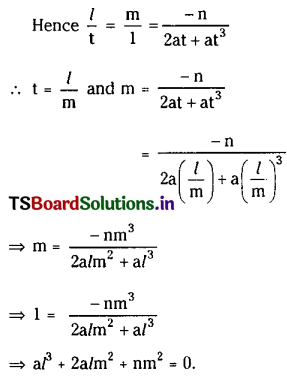
Question 3.
Show that the equation of the common tangents to the circle x2 + y2 = 2a2 and the parabola y2 = 8ax are y = ±(x + 2a). (Mar. ’10, ’09)
Solution:
Given equation of parabola is y2 = 8ax …….(1) and circle is x2 + y2 = 2a2 ……..(2)
The Centre of the circle is C = (0, 0) and the radius of the circle is r = √2a
Equation of the tangent to the parabola (1) having slope ‘m’ is y = mx + \(\frac{2a}{m}\)
⇒ my = m2x + 2a (∵ y2 = 8ax is the parabola)
⇒ m2x – my + 2a = 0 ………(3)
Line (3) is also a tangent to circle (2).
∴ The perpendicular distance from C(0, 0) to line (3) is equal to radius √2a.
∴ \(\left|\frac{2 a}{\sqrt{m^4+m^2}}\right|=\sqrt{2 a}\)
⇒ \(\frac{4 a^2}{m^4+m^2}\) = 2a2
⇒ m4 + m2 – 2 = 0
⇒ m4 + 2m2 – m2 – 2 = 0
⇒ (m2 – 1) (m2 + 2) = 0
⇒ m2 = 1 or m2 = -2
⇒ m2 = 1 (∵ m2 ≠ -2)
⇒ m = ±1
∴ The equations of the required tangents are y = \(\pm x+\frac{2 a}{\pm 1}\)
⇒ y = ±(x + 2a)
Question 4.
Prove that the tangents at the extremities of a focal chord of a parabola intersect at right angles on the directrix.
Solution:
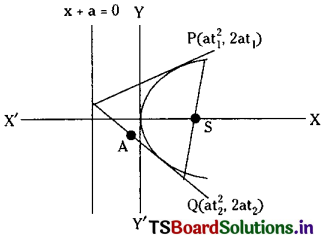
Let y2 = 4ax be the equation of a parabola and
Let P\(\left(a t_1^2, 2 a t_1\right)\), Q\(\left(a t_2^2, 2 a t_2\right)\) be two extremeties of the focal chord.
Since \(\overline{\mathrm{PQ}}\) is the focal chord we have t1t2 = -1 (standard result)
The equation of tangent to the parabola y2 = 4ax at P(t1) is x = \(\mathrm{yt}_1+\mathrm{at}{ }_1^2\) ………(1)
Slope of the tangent (m1) = \(\frac{1}{t_1}\)
The equation of the tangent Q(t2) to the parabola y2 = 4ax is x = \(\mathrm{yt}_2+\mathrm{at}_2^2\) ……..(2)
Slope of the tangent (m2) = \(\frac{1}{t_2}\)
Now m1m2 = \(\frac{1}{t_1 t_2}\) = -1 (∵ t1t2 = -1)
∴ The tangents drawn at P, Q are perpendicular to each other.
The point of intersection of tangents (1) and (2) = [at1t2, a(t1 + t2)]
= [-a, a(t1 + t2)]
Substituting this point of intersection on the directrix of the parabola y2 = 4ax i.e., x + a = 0.
We have -a + a = 0 and hence the point of intersection of tangents lie on the directrix.
∴ The tangents drawn at the extremities of the focal chord of a parabola intersect at right angles on the directrix.
![]()
Question 5.
Find the condition for the line y = mx + c to be a tangent to the parabola x2 = 4ay. (Mar. ’12)
Solution:
Given equation of parabola as x2 = 4ay …….(1)
and given line is mx – y + c = 0 ……..(2)
Suppose (2) is a tangent to the parabola (1).
Let P(x1, y1) be the point of contact.
Then the equation of the tangent to the parabola (1) at (x1, y1) is xx1 – 2a(y + y1) = 0
⇒ xx1 – 2ay – 2ay1 = 0 ………(3)
Since equations (2) and (3) represent the same line, the corresponding coefficients are proportional.
∴ \(\frac{x_1}{m}=\frac{-2 a}{-1}=\frac{-2 a y_1}{c}\)
⇒ x1 = 2am, y1 = -c
Since P(x1, y1) is a point on x2 = 4ay we have \(\mathbf{x}_1^2\) = 4ay1
⇒ (2am)2 = 4a(-c)
⇒ am2 = -c
⇒ c = -am2
∴ The condition for the line y = mx + c to be a tangent to the parabola x2 = 4ay is am2 + c = 0.
Question 6.
Three normals are drawn from (k, 0) to the parabola y2 = 8x one of the normal is the axis and the remaining two normals are perpendicular to each other, then find the value of k.
Solution:
Given equation of parabola is y2 = 8x ………(1)
Comparing with y2 = 4ax we have 4a = 8
⇒ a = 2
The equation of normal to the parabola (1) having slope ‘m’ is
y = mx – 2am – am2
⇒ y = mx – 4m – 2m3
Given that the normal passes through (k, 0).
Then 0 = mk – 4m – 2m3
⇒ m(2m2 + 4 – k) = 0
⇒ m = 0 or 2m2 – k + 4 = 0 ……(2)
Let m1, m2 be the roots of a quadratic equation (2) then
m1 + m2 = 0, m1m2 = \(\frac{4-k}{2}\)
Given that the two normals are perpendicular, we have m1m2 = -1
⇒ \(\frac{4-k}{2}\) = -1
⇒ k = 6
Question 7.
Show that the locus of the point of intersection of the perpendicular tangents to the parabola y2 = 4ax is the directrix x + a = 0.
Solution:
Given y2 = 4ay ………(1) and Let P(x1, y1) be the point of intersection of perpendicular tangents.
Any tangent to the parabola will be of the form y = mx + \(\frac{a}{m}\) of this passes through (x1, y1) then y1 = mx1 + \(\frac{a}{m}\)
⇒ m2x1 – my1 + a = 0 …….(2)
Let m1, m2 be the slopes of tangents drawn from P(x1, y1) to the parabola (1) which corresponds to the roots of a quadratic equation (2).
Then m1 + m2 = \(\frac{y_1}{x_1}\) and m1m2 = \(\frac{a}{x_1}\) …….(3)
Since the tangents are perpendicular we have m1m2 = -1 and hence from (3),
-1 = \(\frac{a}{x_1}\)
⇒ x1 + a = 0
∴ The Locus of (x1, y1) is x + a = 0 which is the equation of the directrix of the parabola (1).
![]()
Question 8.
Two parabolas have the same vertex and equal length of latus rectum such that their axes are at the right angle. Prove that the common tangents touch each at the end of the latus rectum.
Solution:
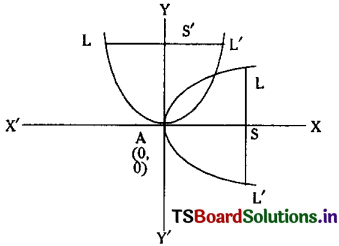
Let the equations of parabolas having the same vertex and equal length of latus rectum be
y2 = 4ax …….(1)
x2 = 4ay …….(2)
Let the equation of the tangent to the parabola (1) having slope ‘m’ is
y = mx + \(\frac{a}{m}\) …….(3)
But this is also a tangent to x2 = 4ay
∴ c = -am2
∴ \(\frac{a}{m}\) = -am2
⇒ m3 = -1
⇒ m = 1
∴ From (3), we have y = -x – a
⇒ x + y + a = 0 ………(4)
L'(a, -2a) is the end of latus rectum of parabola (1).
∴ From (4), x + y + a = a – 2a + a = 0
∴ The common tangents to the parabolas y2 = 4ax, x2 = 4ay will touch the parabola at the end of the latus rectum.
Question 9.
Show that the foot of the perpendicular from focus to the tangent of parabola y2 = 4ax lies on the tangent at the vertex.
Solution:
Given parabola is y2 = 4ax ……….(1)
Equation of any tangent to (1) is of the form y = mx + \(\frac{a}{m}\)
⇒ my = m2x + a
⇒ m2x – my + a = 0 ……..(2)
Equation of the line perpendicular to the line (2) and passing through S(a, 0) is -m(x – a) + m2(y – 0) = 0
⇒ x + my – a = 0 ……..(3)
From (2) and (3)
(m2 + 1)x = 0
⇒ x = 0
From (3), my – a = 0
⇒ y = \(\frac{a}{m}\)
∴ The point of intersection of (2) and (3) is (0, \(\frac{a}{m}\))
∴ The point (0, \(\frac{a}{m}\)) lies on the y-axis which is a tangent at the vertex.
![]()
Question 10.
Show that the tangent at one extremity of a focal chord of a parabola is parallel to the normal at the other extremity.
Solution:
Let y2 = 4ax be the given parabola.
Let P = \(\left(a t_1{ }^2, 2 a t_1\right)\) and Q = \(\left(a t_2{ }^2, 2 a t_2\right)\) be the two extremities of a focal chord. then t1t2 = -1
The equation of the tangent to the parabola at P(t1) is x – yt1 + \(\mathrm{at}_1{ }^2\) = 0 …….(1)
then m1 = \(\frac{1}{t_1}\)
The equation of the normal at Q(t2) is xt2 + y – 2at2 – \(\mathrm{at}_2^3\) = 0 ……..(2)
The slope of the normal (m2) = -t2
= \(-\left(\frac{-1}{t_1}\right)=\frac{1}{t_1}\) (∵ t1t2 = -1)
∴ m1 = m2 and the tangent at P(t1) is parallel to the normal at Q(t2) to the parabola y2 = 4ax.
∴ The tangent at one extremity of a focal chord is parallel to the normal at other extremities.
III.
Question 1.
The normal at a point t1 on y2 = 4ax meets the parabola again at the point t2. Then prove that t1t2 + \(t_1{ }^2\) + 2 = 0.
Solution:
Given equation of parabola is y2 = 4ax ……..(1)
Let P = \(\left(a t_1^2, 2 a t_1\right)\) = P(t1) be any point on (1).
The equation of normal at P(t1) on the parabola (1) is y + xt1 = 2at1 + \(\mathrm{at}_1{ }^3\)
⇒ t1x + y = 2at1 + \(\mathrm{at}_1{ }^3\) ……..(2)
The normal drawn at P(t1) meets the parabola at Q(t2).
∴ PQ is the chord of the parabola.
The equation of chord \(\overline{\mathrm{PQ}}\) of the parabola y2 = 4ax is y(t1 + t2) = 2x + 2at1t2
⇒ 2x = y(t1 + t2) + 2at1t2 = 0 ……….(3)
Since equations (2) and (3) represent the same line, the coefficients of line turns are proportional.
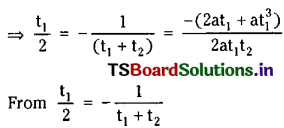
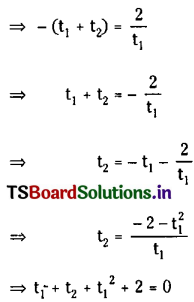
Question 2.
From an external point, P tangents are drawn to the parabola y2 = 4ax and these tangents make angles θ1, θ2 with its axis, such that cot θ1 + cot θ2 is a constant ‘d’. Then show that all such P lies on a horizontal line.
Solution:
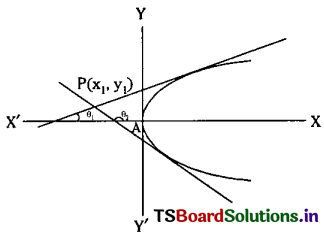
Given y2 = 4ax ………(1) and Let P(x1, y1) be an external point.
Let the equation of a tangent to the parabola (1) having slope ‘m’ is y = mx + \(\frac{a}{m}\) …….(2)
if (2) passes through P(x1, y1) then y1 = mx1 + \(\frac{a}{m}\)
⇒ my1 = m2x1 + a
⇒ m2x1 – my1 + a = 0 …….(3)
Since this is a quadratic equation in ‘m’.
Let m1 and m2 be the roots. Then
m1 + m2 = \(\frac{y_1}{x_1}\) and m1m2 = \(\frac{\mathrm{a}}{\mathrm{x}_1}\)
Given that the tangents are making angles θ1, θ2 with its axis we have m1 = tan θ1 and m2 = tan θ2.
Also given that cot θ1 + cot θ2 = d
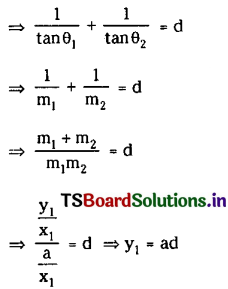
∴ The Locus of P(x1, y1) is y = ad which is a line parallel to X-axis.
∴ P(x1, y1) lies on a horizontal line.
![]()
Question 3.
Show that the common tangents to the circle 2x2 + 2y2 = a2 and the parabola y2 = 4ax intersect at the focus of the parabola y2 = -4ax.
Solution:
Given equation of circle is x2 + y2 = \(\frac{a^2}{2}\) ……..(1)
and the given equation of parabola is y2 = 4 ax ……..(2)
Let y = mx + c be a common tangent to (1) and (2).
If y = mx + c is a tangent to (1) then by the condition of tangency
c2 = \(\frac{a^2}{2}\) (1 + m2) ………(3)
Also if y = mx + c is a tangent to the parabola y2 = 4ax then
c = \(\frac{a}{m}\) …….(4)
∴ From (3) and (4) we have \(\frac{a^2}{m^2}=\frac{a^2}{2}\left(1+m^2\right)\)
⇒ m4 + m2 = 2
⇒ m4 + m2 – 2 = 0
⇒ m4 + 2m2 – m2 – 2 = 0
⇒ (m2 + 2) (m2 – 1) = 0
⇒ m2 + 2 = 0 or m2 – 1 = 0
m2 + 2 = 0 is not admissible.
∴ m2 – 1 = 0
⇒ m = ±1
From y = mx + c we have
= mx + \(\frac{a}{m}\)
= \(\pm x+\frac{a}{\pm 1}\)
= ± x ± a
Also y = ± x ± a satisfy the focus (-a, 0) of the parabola y2 = -4ax.
Hence the common tangents to the circle (1) and parabola (2) intersect at the focus of the parabola y2 = -4ax.
Question 4.
The sum of the ordinates of two points on y2 = 4ax is equal to the sum of the ordinates of two other points on the same curve. Show that the chord joining the first two points is parallel to the chord joining the other two points.
Solution:
Given equation of parabola is y2 = 4ax …..(1)
Let A = \(\left(\mathrm{at}_1{ }^2, 2 \mathrm{at}_1\right)\), B = \(\left(\mathrm{at}_2{ }^2, 2 \mathrm{at}_2\right)\), C = \(\left(\mathrm{at}_3{ }^2, 2 \mathrm{at}_3\right)\) and D = \(\left(\mathrm{at}_4{ }^2, 2 \mathrm{at}_4\right)\) be the four points on the parabola (1).
Given that 2at1 + 2at2 = 2at3 + 2at4
⇒ t1 + t2 = t3 + t4 ………(2)
The equation of the chord \(\overline{\mathrm{AB}}\) of the parabola y2 = 4ax is y(t1 + t2) = 2x + 2at1t2
⇒ 2x – (t1 + t2) y + 2at1t2 = 0 ………(3)
Let m1 be the slope of line (3) then m1 = \(\frac{2}{t_1+t_2}\)
The equation of the chord \(\overline{\mathrm{CD}}\) of the parabola (1) is y(t3 + t4) = 2x + 2at3t4 and slope of this chord m2 = \(\frac{2}{t_3+t_4}\)
∴ From (2) we have t1 + t2 = t3 + t4
Hence m1 = m2
∴ Chord \(\overline{\mathrm{AB}}\) is parallel to the chord \(\overline{\mathrm{CD}}\).
![]()
Question 5.
If a normal chord at a point ‘t’ on the parabola y2 = 4ax subtends a right angle at the vertex then prove that t = ±√2.
Solution:
Given equation of parabola is y2 = 4ax ……(1)
The equation of normal at a point P(t) on (1) is xt + y = (2at + at3) …….(2)
Let the normal at P(t) meet (1) again at Q(t1) then PQ is the chord of the parabola (1)
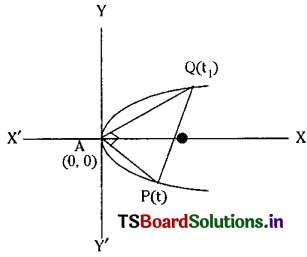
Equation of chord \(\overline{\mathrm{PQ}}\) is y(t1 + t) – 2x – 2at1t = 0
⇒ -2x + (t1 + t)y – 2at1t = 0 ………(3)
Equations (2) and (3) represent the same straight line.
∴ Coefficients of like terms are proportional
